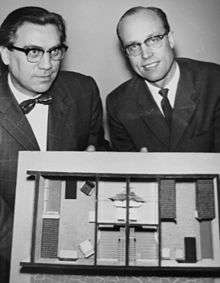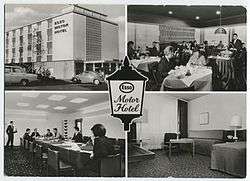Esso Motor Hotel
Esso Motor Hotel was a Swedish subsidiary of the American oil company Esso, for running hotels in Europe.

 | |
Native name | Motorby |
|---|---|
| Founded | 1963 in Laxå, Sweden |
| Headquarters | |
| Services | Rest stops for travelers by car |
History
In the sixties of the twentieth century, with the rise of the numbers of travelers by car, the Scandinavian governments asked for dormitories for motorists at the service stations along the highways.[1] The first that offered bedrooms to motorists was the Swedish Esso filling station along the E20 in Laxå, halfway between Stockholm and Göteborg, resulting in a complete Motorby in 1963 and the establishing of Esso Motor Hotel AB. A Motorby (Swedish for Motor village), is a filling station with workshop combined with a hotel specially for motorists with direct access from the parking to the rooms. All rooms and services, as a shop and cafeteria, are situated at ground floor level. The first motorby at Laxå was followed soon by motorbys at Härnosand, Östersund[2] and Vara and a motel in Örkelljunga. The later built Esso Motor Hotels were provided with far more features than a motorby, as a waiter served restaurant, bank, fitness room, sauna, pool and meeting rooms, mainly to satisfy business travelers. The first three motorbys were upgraded to Esso Motor Hotel, but Vara and Örkelljunga were rated as Esso Motel with minimized services.
Until the splitting at the beginning of 1973, 59 Esso Motor Hotels were opened:[3] 27 in Sweden, 3 in Norway, 2 in Denmark, 3 in the Netherlands, 3 in Italy, 8 in the United Kingdom (notably at Wembley Park, Wembley), 1 in Austria, 10 in Germany and 2 in Belgium. The chain had an internal reservation system by which the customer could book the Esso Motor Hotel for the next stage of his journey. The hotels outside Scandinavia were managed by Esso Motor Hotel inc. in London.
The Esso Route

After the first three motor hotels in Sweden expansion abroad followed in 1965. The Scandinavian holidaymaker should be able to drive to the Italian coast using Esso Motor Hotels during the journey. The Hotels were situated in a one-day driving distance from each other. The northern end of this "Esso route" was Mölndal[4] in Sweden which opened in 1966, the southern end was Brescia in Italy which opened in 1965. The Swedish-Danish bordercrossing was made by ferry at Helsingborg, from Denmark to Germany the route followed the, then new, Vogelfluglinie. In Germany the HaFraBa autobahn route was chosen and south of Basle the route of the present E25 through Switzerland, France and the new Mont Blanc Tunnel. In Italy Brescia was reached through Valle d'Aosta and the Autostrada Serenissima. The intermediate hotels were situated in Hannover, Courmayeur,[5] Freiburg and Glostrup (Copenhagen). From Brescia the tourists could follow their way to the various resorts on the Adriatic in Italy as well as in Yugoslavia. More differentiation was created in 1967 by two more Hotels, Heidelberg and Sindelfingen in the south of Germany. In Sweden the hotels at Nörrköping and Jönköping were opened in 1967 too. These two enabled the travellers from and to Stockholm to follow the direct route from Stockholm to Helsingborg instead of the longer one via Laxå and Mölndal. In 1969 the southern end shifted to Florence, but Esso's Italian partner Pavesi built five hotels between Florence and Sicily. From the initial plan for the route from Trondheim in the North to Sicily in the South only the hotel in Trondheim was added afterwards.
Expansion
Fourteen hotels were in use in February 1968,[6] six of them in Sweden and an ambitious expansion plan has been launched. The word "Motel" was avoided in order to emphasize the extra features the "Motor Hotel" provides compared to a normal motel. In Sweden the number of hotels should raise to 19 by half 1968, 27 by 1969 and 35 by 1970.[7] In 1968 the British holidaymakers were connected with the Esso route from the hotel in South Mimms via the carferries to Belgium and the new hotel in Born in the Netherlands. In Denmark the hotel in Billund was opened together with Legoland. In Casteau (Belgium) a hotel was opened next to SHAPE situated in Casteau since 1 April 1967 and in Maidenhead a new hotel was combined with the Esso trainingcentre.[8] The number of hotels had been more than doubled by the end of 1968, although the expansion in Sweden was behind schedule. After 1968 the growth slowed down and the next doubling wasn't reached until the end of 1972. Further expansion followed mainly in Scandinavia and with more business related hotels in Germany, Belgium and the Netherlands (Antwerp and Amsterdam in 1969 and Velp in 1970). Edinburgh still expected tourists as customers[9] but business travellers got a bigger share in Britain as well. From 1970 on new hotels were built with at least 100 rooms and smaller hotels were enlarged. At the beginning of 1972 many, also American, competitors from Esso Motor Hotel were building or completing several hotels in the European cities and Esso had several hotels nearing completion in Norway, Britain[10] and Germany.[11] These new beds were added to the hotel capacity already created since the mid sixties resulting in a surplus of rooms.
New owners
The saturation of the hotel market in the European cities and the need for cash to finance the oil exploration did Esso decide to sell the hotels outside of Scandinavia.
Crest
The hotel in Freiburg was sold, the nine remaining German and the only Austrian Hotel were leased to Crest Hotels at the end of 1972. The other hotels outside Scandinavia, including the ninth British hotel at that time under construction at Runcorn,[12] were sold to Crest Hotels as part of the same deal. From 1976 on the 17 hotels bought by Crest were rebranded as EuroCrest Hotel. In 1976 Crest wanted to double the number of hotels in Germany and bought the leased hotels in Germany and Austria[13] that were rebranded as Eurocrest as well. Eventually Crest sold all its "Esso Motor Hotels" to other hotel chains.
Scandinavia
After the deal with Crest at the end of 1972, 32 hotels remained in Scandinavia, 27 of them in Sweden.
The Danish hotels were sold as well in the seventies, in 1974 Lego bought the hotel in Billund renaming it in Vis-a-Vis Hotel and later on Hotel Legoland. In 1979 the Glostrup hotel changed to Glostrup Park Hotel. Meanwhile, the expansion in Sweden and Norway continued from 28 in Sweden in 1974 to 44 in October 1976.[14] Besides the Esso Motor Hotels the chain created parallel markets of hotels, without motorist services, in cities branded as Esso Scandic and Esso Motels, such as Örkelljunga and Vara, with minimized services. Esso also operated roadside restaurants branded as Taverna. In 1977 Esso Motor Hotels owned 10% of the hotelcapacity in Sweden but had a 25% marketshare. In 1983 Esso decided to leave the hotel business. At that time 41 Esso Motor Hotels, 8 Esso Scandic Hotels and 6 Esso Motels were operated in Sweden. The locations in Sweden and Norway were sold to a group of investors. After the detachment from the Esso-company in 1984 the Hotel-chain changed its name in Scandic Hotels.
Esso Motor Hotels
See also
- List of hotels
- List of motels
Notes
- Der Spiegel, 1 Jan. 1973, page 33
- Grandprix 63. "Motorby". Grandprix63.blogspot.nl. Retrieved 2013-10-15.
- Der Spiegel, 1 Jan. 1973, page 32
- http://grandprix63.blogspot.nl/search?q=esso+motor+hotel
- Aruba Esso News, 7 Oct. 1966
- AR-Zeitung nr. 8/1968, 22 Feb. 1968 page 37
- Die Zeit 1967 nr.40, 6 Oct. 1967 "Totale Selbstbedienung"
- Concrete Quarterly, edition 79, Oct-Dec 1968, Londen Dec. 1968
- Glasgow Herald, 22 May 1970
- Glasgow Herald, 22 Nov. 1972
- Die Zeit 1972 nr.17, 28 Apr. 1972, "Kein Geld für deutsche Betten"
- Glasgow Herald, 20 Feb. 1973
- Die Zeit 1976 nr.50, 3 Dec. 1976, "Goldene Crest Zeiten"
- Die Zeit 1976 nr.43, 15 Oct. 1976, "Schweden bittet sich billig an"
- "Archived copy". Archived from the original on 2012-11-07. Retrieved 2012-11-07.CS1 maint: archived copy as title (link)
References
- 115 Anni Esso Italiana 1891-2006, Rome 2006